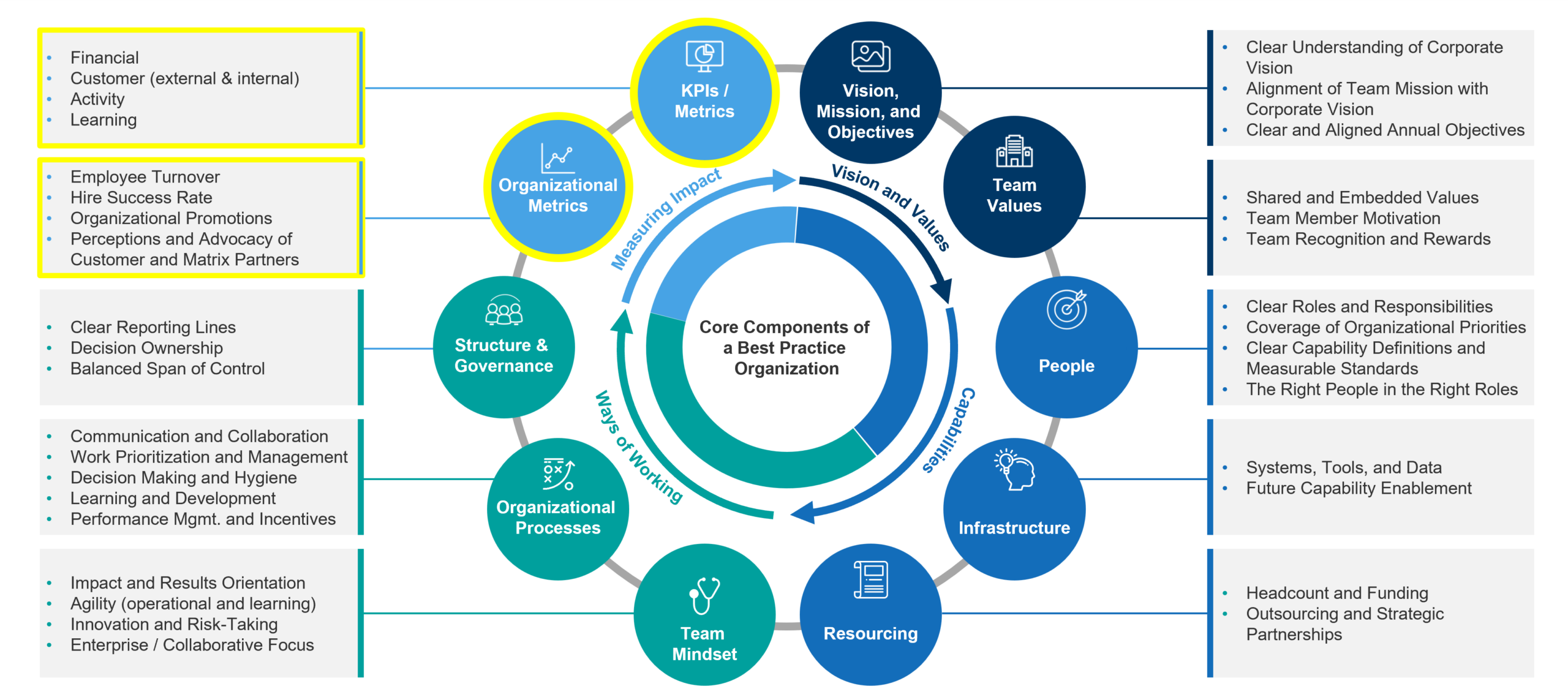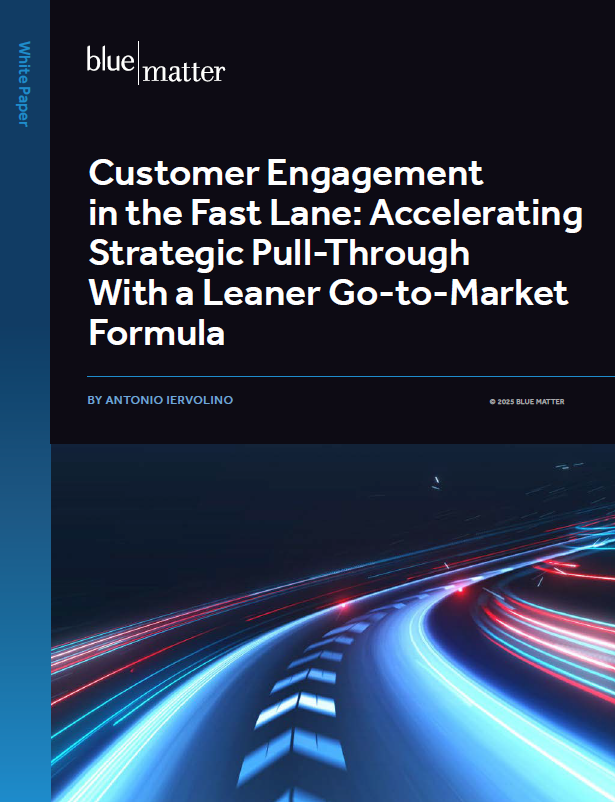
For a biopharma company to be a Best Practice Organization (BPO), it must develop frameworks for measuring the impact of its activities. In this series about what it takes to be a BPO, we have previously examined the importance of having clear vision, mission, and values; capabilities; and ways of working. As valuable as those factors are, companies are unlikely to maximize their value without also prioritizing the fourth component of being a BPO: capabilities for measuring performance.
In this piece, the final article in the series, we examine how BPOs measure the impact of what they do. We first look at key performance indicators (KPIs) with supporting metrics and how to use them, and then we turn to several organizational metrics that companies can use to assess the specific impact of their performance.
Key Performance Indicators
Best practice organizations track performance across a range of metrics, which need to reflect their objectives and priorities. They must also enable the organization to measure performance but also diagnose enhancement opportunities. The most important or priority metrics become Key Performance Indicators that are typically tracked more broadly across the organization and are usually made up of multiple metrics.
Many companies have traditionally focused their KPIs toward tracking financial outcomes, in the belief that the bottom line was the only standard that mattered. But starting with a landmark 1992 article in Harvard Business Review, organizations have understood that success depends on using a “balanced scorecard” that measures performance and enables a diagnosis of the organization across multiple financial and operational dynamics. A more balanced set of KPIs includes measures like customer satisfaction, internal processes, and innovation efforts, which can help drive financial performance.
Balanced Scorecard Framework (and example KPIs)
|
|
|
|
Financial KPIs such as revenue growth, profitability, and cost savings are typically the most important for a company to track. Organizations should ideally tie financial metrics to their objectives and to their financial situation. Emerging organizations typically are focused on cash flow, particularly when funding availability in the capital markets is more constrained. Growth organizations typically prioritize increasing revenue and are willing to sacrifice short-term profitability to achieve growth objectives. Long term, organizations do need to focus on profitability, and typically public and private equity-backed organizations will prioritize it.
We see that in non-best practice organizations, financial metrics are used without regard for how relevant or connected they are to the financial situation of the organization. In a Best Practice Organization, however, financial metrics are tailored to be both relevant to the financial situation of the organization and connected to its specific situation and organizational objectives. For instance, a best practice organization that is growing faster than the competition in a highly competitive market may want to use a metric like relative share change that shows whether they are winning market share from competitors.
Beyond financial metrics, BPOs are also effective at tracking customer-focused KPIs, both for external and internal customers. Non-BPOs loosely use ad hoc customer feedback and general revenue data to track customer satisfaction, and some may even look at a combination of qualitative customer feedback and quantitative metrics such as customer performance data, customer satisfaction surveys, and Net Promoter Score, although they tend not to be tailored to the organization’s unique situation. BPOs, however, use specific qualitative and quantitative customer metrics, including leading and lagging indicators and the structured capture of qualitative feedback, tailoring them to the organization’s unique situation. An example that we’ve seen is a rare disease customer facing-team that worked with caregivers to track monthly feedback on a number of important dimensions, such as the reimbursement experience for the provider. The organization tracked the second referral from an HCP after a typical period of time for a reimbursement. This metric confirmed a positive provider reimbursement experience.
Another important KPI is activity tracking. One mark of a non-BPO is tracking activity metrics such as general frequency or utilization, but they tend to be ad hoc and not aligned to organizational objectives. BPOs, though, use quantitative and qualitative customer metrics and feedback that are tailored for the organization. An example of this would be the rollout of a new business process. Typical metrics would just include tracking the utilization of a new process, which could in many cases be mandatory, so a high utilization does not measure the effectiveness of the new process. The KPI would ideally include metrics such as cost or time savings from utilization of the new process. It should also include qualitative feedback that demonstrates examples of how team members leveraged the process to improve their delivery against organizational objectives and priorities.
Finally, performance with learning and innovation is an essential KPI. These factors tend to simply not be tracked in developing organizations, with no capability for learning from innovation and the failures that can come out of that process. Companies that are not BPOs do use metrics that assess how they innovate and learn from innovation—such as the effectiveness of a new business model or the impact of new internal processes to reduce FTE work time—but those metrics tend not to be used consistently and do not have a direct impact on organization’s performance.
In BPOs, however, metrics are in place to measure how the company innovates and learns from their innovations and failures. These metrics have a long-term focus, are used consistently, and are relevant to the impact the organization drives, including creating a growth culture with a tolerance for innovation and risk. An example of this is an organization measuring the effectiveness of deploying an innovative omnichannel engagement program. A BPO would typically measure the number of new ideas generated by customer-facing and home office-based team members that result in adjustments to customer engagement or call frequency; processes to increase the effectiveness of interactive visual aids, including time used or length of details; customization of digital messages; and number of new ideas for follow-ups delivered to customer-facing team members. The KPIs should also integrate qualitative feedback from team members using the platform and, where possible, customer acknowledgement of better engagement over a reasonable period of time.
Organizational Metrics
Measuring a company’s performance with its organizational goals is just as important as tracking its more externally facing KPIs. These metrics should be thought of as part of the learning and innovation section of a balanced scorecard, but we break them out here and examine them in greater detail because of their importance for organizations. Getting these organizational metrics right can be challenging, but it’s an essential part of being a BPO.
The first of these organizational metrics is employee turnover: the rate of team members who leave the organization each year. In non-best practice organizations, this number is fairly high, with frequent turnover at all levels of the organization. Best Practice Organizations, however, have very low turnover, especially for high performers, with most of that attributable to individuals’ growth in their roles.
Some organizations believe some turnover is productive. At General Electric, for example, former CEO Jack Welch used to manage out the bottom 10% of the organization each year. He felt that it was the most fair approach for employees because it did not allow them to stagnate in a role and gave them the opportunity to make changes to enhance their career. BPOs typically measure employees on some form of curve, rewarding the highest 10%-20% of employees with a combination of increased compensation, promotions, and development opportunities. Those organizations also provide the bottom 10% of team members with a combination of coaching, mentoring, and transition opportunities to other roles that may be more aligned to their capabilities.
In addition, many companies run engagement surveys internally, and these serve as a strong data point for corporate decision-making. In non-BPOs, these surveys can be overindexed, with their findings treated as the only actionable data points and given greater priority than they may merit. However, Best Practice Organizations balance the input from employee engagement surveys with other organizational metrics to ensure that they’re executing on the most appropriate actions rather than over-reacting to qualitative feedback.
Hire success rate—the ratio of candidates who operate at a company-defined standard for high performance relative to all hired candidates—is another important organizational metric. The number tends to be fairly low outside of Best Practice Organizations, often due to unstructured hiring criteria and processes, ineffective staff development or new leadership teams. Standard practice organizations can see much higher hire success rates, thanks to more established hiring criteria and pipelines. And in BPOs, the rate can be very high relative to industry peers, as hiring criteria and pipelines are validated by the team.
Another important organizational metric is the percentage of promotions that are made from within the company. Non-Best Practice Organizations tend not to have a deep “bench” within the company, so they are frequently hiring for new roles from outside. The promotions that those companies do make are usually within functional areas. Because BPOs prioritize building a bench and building promotional pathways within the company, their promotion rate is much higher than industry peers.
Finally, advocacy for the company by customers and internal cross-functional partners is another key organizational metric that BPOs prioritize. This metric is a reflection of how companies are perceived and the trust that they build with the other organizations they work with. In non-BPOs, there is either no or very little advocacy by partners. BPOs, however, build strong relationships with all customers and cross-functional matrix partners, and that positive regard is held almost universally.
| Measuring Impact Case Study A global pharmaceutical company was developing a new organizational operating model as part of a larger business transformation project. To assess how well the new model was supporting the transformation, the company pulled together a combination of quantitative and qualitative data. Quantitative data included financial performance, customer satisfaction, activity metrics, and innovations in partnerships with different types of customers. Qualitative data came from a series of short meetings with internal stakeholders and priority customers, where they were asked the same short set of questions. They then used the balance of quantitative and qualitative information to develop a short list of recommended enhancements that senior leadership could approve to execute in the near term. The qualitative and quantitative research helped the new operating model succeed, and it enabled the company to achieve its strategic business objectives and improve customer satisfaction. |
Conclusion
As we’ve seen, the four components that can make a biopharma company into a Best Practice Organization—vision, mission, and values; capabilities; ways of working; and measuring impact—are critical in today’s highly competitive, rapidly changing environment. And much of the time, they can make the difference between a company that achieves its goals and one that is left behind by its competitors.








